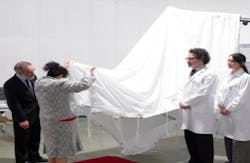|
Featured Articles
|
BIRMINGHAM — A look back at the news coverage on WEFTEC 2014 featured in WaterTech e-News Daily throughout 2014.
BOISE, Idaho — The booklet was authored by the Water Quality Association (WQA).
ANN ARBOR, Mich. — The American National Standard, “NSF/ANSI 401: Drinking Water Treatment Units – Emerging Compounds/Incidental Contaminants,” addresses a water treatment device’s ability to remove up to 15 varying contaminants.
BOSTON — Lux Research has found that recovery of resources from wastewater streams is becoming increasingly feasible.
WICHITA FALLS, Texas — In the fourth year of “exceptional drought,” the city’s water restrictions are severe.
RESTON, Va. — The report is part of an ongoing investigation of contamination from the East Poplar oil field.
ROCHESTER, N.Y. — The group highlighted the Theory of Microcompetition with Foreign DNA and a recent study of treated sewage by Food and Environmental Virology.
NEW YORK — The report from Bank of America Merrill Lynch Global Research outlines water scarcity in the next few decades.
FOUNTAIN VALLEY, Calif. — The CBS News’ program “60 Minutes” featured a report on how one water district is recycling millions of gallons of wastewater a day into purified drinking water.
WASHINGTON — The two funded centers will develop and test advanced, low-cost methods to reduce, control and eliminate groups of water contaminants that present challenges to communities around the world.
ALEXANDRIA, Va. — The Bottled Water Quality Information Act requires bottled water producers to annually prepare a bottled water quality report.
WASHINGTON — The Bureau is seeking proposals from universities, water utilities, private industry and others.
WESTERVILLE, Ohio — The newly released best suggested practices (BSPs) were developed through consensus of industry professionals with day-to-day experience in aquifer storage and recovery (ASR) system design and operation.
BURNABY, British Columbia — The global water purifiers’ market revenues are anticipated to grow at the compounded annual growth rate of around 10 percent during 2013-2018.
About the Author
Sign up for our eNewsletters
Get the latest news and updates















